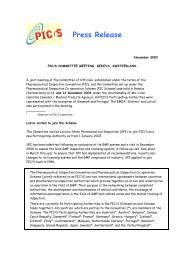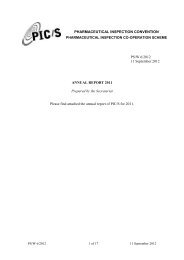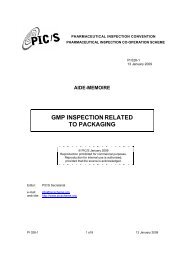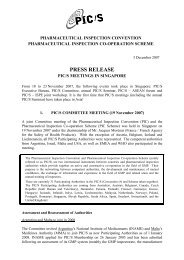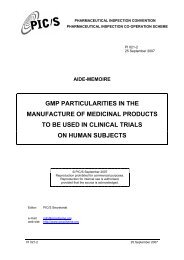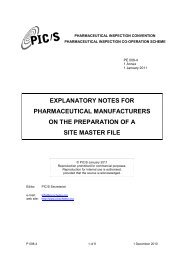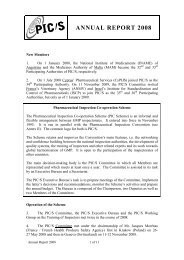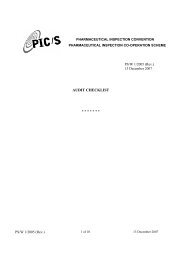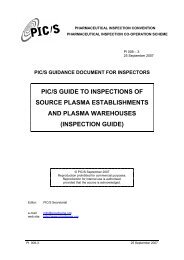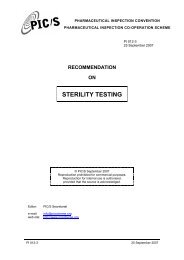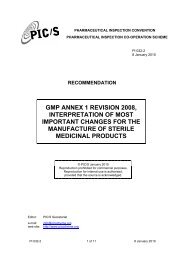a recommended model for risk-based inspection planning in ... - PIC/S
a recommended model for risk-based inspection planning in ... - PIC/S
a recommended model for risk-based inspection planning in ... - PIC/S
- No tags were found...
Create successful ePaper yourself
Turn your PDF publications into a flip-book with our unique Google optimized e-Paper software.
PHARMACEUTICAL INSPECTION CONVENTIONPHARMACEUTICAL INSPECTION CO-OPERATION SCHEMEPI 037-12 Appendices1 January 2012RECOMMENDATIONA RECOMMENDED MODEL FORRISK-BASED INSPECTIONPLANNING IN THE GMP ENVIRONMENT© <strong>PIC</strong>/S January 2012Reproduction prohibited <strong>for</strong> commercial purposes.Reproduction <strong>for</strong> <strong>in</strong>ternal use is authorised,provided that the source is acknowledged.Editor:<strong>PIC</strong>/S Secretariate-mail: <strong>in</strong>fo@picscheme.orgweb site: http://www.picscheme.orgPI 037-1 Page 1 of 17 1 January 2012
TABLE OF CONTENTS1. Document history 22. Introduction 23. Purpose 34. Scope 35. At what stage should an Inspectorate start to apply thistool to a specific company? 46. Description of this Quality Risk Management tool 47. How to use this Quality Risk Management tool 68. Revision history 12Appendices 13page1. Document HistoryAdoption by Committee of PI 037-1 19 December 2011Entry <strong>in</strong>to <strong>for</strong>ce of PI 037-1 1 January 20122. Introduction2.1. This <strong>PIC</strong>/S Recommendation sets out a simple and flexible Quality RiskManagement tool that may be used by Inspectorates when <strong>plann<strong>in</strong>g</strong> thefrequency and scope of GMP. It is a methodology that is <strong>based</strong> upon theconcept of rat<strong>in</strong>g manufactur<strong>in</strong>g sites on the basis of an estimated <strong>risk</strong> that theymay pose to patients, consumers, animals and users of medic<strong>in</strong>es. Themethodology also takes <strong>in</strong>to account the <strong>risk</strong> to product quality.2.2. The methodology provides a simple two-page quality <strong>risk</strong> managementworksheet that is designed to be completed by Inspectors immediatelyfollow<strong>in</strong>g an <strong><strong>in</strong>spection</strong> at the site. The worksheet is presented <strong>in</strong> Appendix 1to this document and is designed to not require more than several m<strong>in</strong>utes tocomplete.2.3. This Quality Risk Management tool was designed <strong>in</strong> l<strong>in</strong>e with the pr<strong>in</strong>ciples,concepts and guidance set out <strong>in</strong> the follow<strong>in</strong>g official documents:• ICH Q9 - Quality Risk Management• Annex 20 to the <strong>PIC</strong>/S GMP Guide• The EMA Compilations of Community Procedures Document No.INS/GMP/499073/2006 – A Model <strong>for</strong> <strong>risk</strong>-<strong>based</strong> <strong>plann<strong>in</strong>g</strong> <strong>for</strong><strong><strong>in</strong>spection</strong>s of Pharmaceutical Manufacturers• ICH Q10 – Pharmaceutical Quality SystemsPI 037-1 Page 2 of 17 1 January 2012
2.4. In accordance with the a<strong>for</strong>ementioned EMA Compilations of CommunityProcedures Document, the Quality Risk Management tool outl<strong>in</strong>ed <strong>in</strong> this <strong>PIC</strong>/SRecommendation pre-supposes that every manufacturer will be <strong>in</strong>spected atleast once every three years and it is designed to reflect this.3. Purpose3.1. The purpose of this <strong>PIC</strong>/S Recommendation is to provide a simple andqualitative Quality Risk Management tool that may be of use to Inspectorates toprioritize sites <strong>for</strong> <strong><strong>in</strong>spection</strong> when <strong>plann<strong>in</strong>g</strong> the frequency and scope of GMPInspections.4. Scope4.1. The scope of this <strong>PIC</strong>/S Recommendation is limited to the follow<strong>in</strong>g:• The <strong>plann<strong>in</strong>g</strong> of rout<strong>in</strong>e GMP Inspections of active substance andmedic<strong>in</strong>al product manufacturers by the Inspectorates of countries thatare members of the <strong>PIC</strong>/S.• The <strong>plann<strong>in</strong>g</strong> of rout<strong>in</strong>e GMP Inspections of Investigational Medic<strong>in</strong>alProduct (IMP) manufacturers by the Inspectorates of countries that aremembers of the <strong>PIC</strong>/S.• Follow-up activities, such as assign<strong>in</strong>g a new <strong>risk</strong> rat<strong>in</strong>g to the sitefollow<strong>in</strong>g the receipt of new <strong>in</strong><strong>for</strong>mation about the site or its products.(Note: this normally occurs between <strong><strong>in</strong>spection</strong>s and the types of new<strong>in</strong><strong>for</strong>mation might <strong>in</strong>clude <strong>in</strong><strong>for</strong>mation on quality defects, product recalls,market surveillance test results, etc.)• Note: While this methodology has not been designed <strong>for</strong> the <strong>plann<strong>in</strong>g</strong> ofGDP <strong><strong>in</strong>spection</strong> programmes or <strong>for</strong> the <strong>plann<strong>in</strong>g</strong> of <strong><strong>in</strong>spection</strong>s atpharmacies, some countries may choose to use it as a basis <strong>for</strong> thosepurposes and it may be of help <strong>in</strong> those areas.4.2. The scope of this <strong>PIC</strong>/S Recommendation does not extend to the follow<strong>in</strong>g:• The actual conduct of an <strong><strong>in</strong>spection</strong>.• The <strong>plann<strong>in</strong>g</strong> of <strong><strong>in</strong>spection</strong>s at new manufacturers be<strong>for</strong>e any <strong><strong>in</strong>spection</strong>has taken place.o This methodology requires a knowledge of the GMP compliancestatus of the site. It is considered that new sites should not be rated<strong>for</strong> their <strong>in</strong>itial <strong><strong>in</strong>spection</strong> <strong>in</strong> accordance with this Quality RiskManagement tool, because the Inspectorate <strong>in</strong> question will not likelyhave sufficient knowledge about the site to assign a <strong>risk</strong> rat<strong>in</strong>g to thatsite, and national legislation will likely dictate when such <strong><strong>in</strong>spection</strong>sshould be carried out. (However, certa<strong>in</strong> aspects of this methodology,PI 037-1 Page 3 of 17 1 January 2012
such as the <strong>in</strong>tr<strong>in</strong>sic <strong>risk</strong> evaluation, may be useful to apply to newsites when <strong>plann<strong>in</strong>g</strong> <strong><strong>in</strong>spection</strong>s at new sites.)• The <strong>plann<strong>in</strong>g</strong> of non-rout<strong>in</strong>e and emergency <strong><strong>in</strong>spection</strong>s atmanufacturers, such as when a Critical deficiency or many Majordeficiencies have been identified dur<strong>in</strong>g a recent <strong><strong>in</strong>spection</strong>.o It is usually not necessary or <strong>in</strong>deed helpful to use a <strong>for</strong>mal QualityRisk management methodology such as this one to determ<strong>in</strong>ewhether a non-rout<strong>in</strong>e or emergency <strong><strong>in</strong>spection</strong> should be per<strong>for</strong>med.• The <strong>plann<strong>in</strong>g</strong> of <strong>for</strong>-cause <strong><strong>in</strong>spection</strong>s that must be carried <strong>in</strong> order toapprove or reject a variation application to a Market<strong>in</strong>g or Manufactur<strong>in</strong>gAuthorisation.• The methodology presented <strong>in</strong> this <strong>PIC</strong>/S Recommendation was notdesigned to apply to the <strong><strong>in</strong>spection</strong> of blood and tissue establishments,but it may be modified <strong>for</strong> application <strong>in</strong> this area.5. At what stage should an Inspectorate start to apply this tool to a specificcompany?5.1. This Quality Risk Management tool should not normally be applied to a site untila full <strong><strong>in</strong>spection</strong> at the site has occurred. This is because the compliancestatus of the site needs to be determ<strong>in</strong>ed <strong>in</strong> order to use this tool.5.2. If a site has had one <strong>in</strong>itial <strong><strong>in</strong>spection</strong> but if the Inspectorate <strong>in</strong> questionconsiders that this <strong>in</strong>itial <strong><strong>in</strong>spection</strong> was not a ‘full’ <strong><strong>in</strong>spection</strong> of the site andthat one or more additional <strong><strong>in</strong>spection</strong>s are required be<strong>for</strong>e the site can beconsidered to have had a ‘full’ <strong><strong>in</strong>spection</strong>, such sites should not be rated us<strong>in</strong>gthis Quality Risk Management tool until they have been subjected to a ‘full’<strong><strong>in</strong>spection</strong>.,5.3. A useful rule of thumb to use is that the tool should not be applied to a site untilthe site has been granted a Manufactur<strong>in</strong>g Authorisation and/or a GMPCertificate, as these actions <strong>in</strong>dicate that the site will have been assessed froma compliance perspective.6. Description of this Quality Risk Management tool6.1. This Quality Risk Management methodology is a simple tool that allowsInspectorates to assign a relative <strong>risk</strong> rat<strong>in</strong>g to manufacturers when <strong>plann<strong>in</strong>g</strong>the rout<strong>in</strong>e <strong><strong>in</strong>spection</strong> programme <strong>for</strong> those sites.6.2. The <strong>risk</strong> rat<strong>in</strong>gs that are generated us<strong>in</strong>g this methodology may then be usedby the Inspectorate to assign a frequency to the rout<strong>in</strong>e <strong><strong>in</strong>spection</strong>s that will beper<strong>for</strong>med at the various manufacturers under its supervision.6.3. The <strong>risk</strong> rat<strong>in</strong>gs that are assigned to sites are <strong>based</strong> on an assessment of twodifferent k<strong>in</strong>ds of <strong>risk</strong> - an <strong>in</strong>tr<strong>in</strong>sic <strong>risk</strong> and a compliance-related <strong>risk</strong>.PI 037-1 Page 4 of 17 1 January 2012
6.3.1. The <strong>in</strong>tr<strong>in</strong>sic <strong>risk</strong> estimated <strong>for</strong> a site reflects the complexity of the site, itsprocesses and products as well as the criticality of the products or servicesprovided by the site <strong>in</strong>clud<strong>in</strong>g from a supply perspective. These items(complexity and criticality) usually rema<strong>in</strong> fairly constant regardless of thecompliance status of the site. There<strong>for</strong>e, one usually cannot estimate this <strong>risk</strong>on the basis of <strong><strong>in</strong>spection</strong> deficiencies or compliance history. (Note: the term‘<strong>in</strong>tr<strong>in</strong>sic <strong>risk</strong>’ refers to the <strong>in</strong>herent <strong>risk</strong> that is associated with a site, itsprocesses and products, regardless of the compliance status of the site.)6.3.2. The compliance-related <strong>risk</strong> that is estimated <strong>for</strong> the site reflects the GMPcompliance status of the site immediately follow<strong>in</strong>g the most recent rout<strong>in</strong>e<strong><strong>in</strong>spection</strong> at the site. When this <strong>risk</strong> is be<strong>in</strong>g estimated, the classification andnumber of deficiencies identified at the last <strong><strong>in</strong>spection</strong> are taken <strong>in</strong>to account.6.3.3. Note: Guidance on how to assess the <strong>in</strong>tr<strong>in</strong>sic <strong>risk</strong> is provided <strong>in</strong> Appendix 2.This is important to read be<strong>for</strong>e us<strong>in</strong>g the tool. A table is provided <strong>in</strong> theworksheet show<strong>in</strong>g how to assess the compliance-related <strong>risk</strong>.6.4. Once the <strong>in</strong>tr<strong>in</strong>sic <strong>risk</strong> and the compliance-related <strong>risk</strong> associated with the sitehave been estimated, those two <strong>risk</strong>s are then comb<strong>in</strong>ed us<strong>in</strong>g a simple matrixto generate a relative <strong>risk</strong> rat<strong>in</strong>g <strong>for</strong> the site. It is this <strong>risk</strong> rat<strong>in</strong>g that isconsidered when decid<strong>in</strong>g the frequency of the next rout<strong>in</strong>e <strong><strong>in</strong>spection</strong> at thesite.6.5. With regard to the scope of the next rout<strong>in</strong>e <strong><strong>in</strong>spection</strong> at the site, this is notdeterm<strong>in</strong>ed us<strong>in</strong>g the <strong>risk</strong> rat<strong>in</strong>g that is assigned to the site. Instead, thisQuality Risk Management methodology requires certa<strong>in</strong> other items to beconsidered when the <strong>recommended</strong> scope of the next <strong><strong>in</strong>spection</strong> is be<strong>in</strong>gdocumented.6.6. These other items are:6.6.1. The required focus and depth of the next rout<strong>in</strong>e <strong><strong>in</strong>spection</strong> of the site.6.6.2. The required duration of the next rout<strong>in</strong>e <strong><strong>in</strong>spection</strong> of the site.6.6.3. The required number of <strong>in</strong>spectors to be assigned to the next rout<strong>in</strong>e <strong><strong>in</strong>spection</strong>of the site6.6.4. Whether any specific competence or expertise will be required on the<strong><strong>in</strong>spection</strong> team when per<strong>for</strong>m<strong>in</strong>g the next rout<strong>in</strong>e <strong><strong>in</strong>spection</strong> of the site.6.7. When determ<strong>in</strong><strong>in</strong>g the required focus and depth of the next rout<strong>in</strong>e <strong><strong>in</strong>spection</strong>,the methodology requires the <strong>in</strong>spector to consider the follow<strong>in</strong>g items be<strong>for</strong>emak<strong>in</strong>g his/her recommendation:6.7.1.1. The areas <strong>in</strong> which deficiencies were identified dur<strong>in</strong>g the most recent<strong><strong>in</strong>spection</strong> at the site, particularly major and critical deficiencies;6.7.1.2. The areas that were not <strong>in</strong>spected (or that were not <strong>in</strong>spected <strong>in</strong> detail) dur<strong>in</strong>gthe most recent <strong><strong>in</strong>spection</strong> at the site;PI 037-1 Page 5 of 17 1 January 2012
6.7.1.3. The areas that were considered dur<strong>in</strong>g the last <strong><strong>in</strong>spection</strong> to have been<strong>in</strong>adequately resourced at the site;6.7.1.4. Any other area that the <strong>in</strong>spector feels requires detailed review at the next<strong><strong>in</strong>spection</strong>.6.8. The <strong>recommended</strong> scope of the next rout<strong>in</strong>e <strong><strong>in</strong>spection</strong> is documented on theworksheet after the last <strong><strong>in</strong>spection</strong> has been per<strong>for</strong>med at the site. The personwho should do this will normally be the <strong>in</strong>spector who led the last <strong><strong>in</strong>spection</strong> atthe site <strong>in</strong> question. (This approach is advantageous because it utilises theexist<strong>in</strong>g knowledge of the <strong>in</strong>spector who most recently <strong>in</strong>spected the site.)6.9. This methodology recognises that new <strong>in</strong><strong>for</strong>mation on the compliance status ofthe site or on its activities and products may be received by the Inspectorateafter the site has been rated us<strong>in</strong>g this methodology to determ<strong>in</strong>e the frequencyof the next rout<strong>in</strong>e <strong><strong>in</strong>spection</strong>, and after the scope of the next rout<strong>in</strong>e <strong><strong>in</strong>spection</strong>has been documented.6.9.1. Such new <strong>in</strong><strong>for</strong>mation may relate to new quality defect reports, Market<strong>in</strong>gAuthorisation variation applications affect<strong>in</strong>g the site, product recall actions,non-con<strong>for</strong>m<strong>in</strong>g market surveillance test results or other general <strong>in</strong>dicators ofnon-compliance, such as a failure to implement a Market<strong>in</strong>g Authorisationvariation on time.6.9.2. The methodology allows <strong>for</strong> the frequency and/or scope of the next rout<strong>in</strong>e<strong><strong>in</strong>spection</strong> to be cont<strong>in</strong>ually updated as such new <strong>in</strong><strong>for</strong>mation comes to light.(Note: In cases where such new <strong>in</strong><strong>for</strong>mation is such that a non-rout<strong>in</strong>e<strong><strong>in</strong>spection</strong> of the site is warranted to follow-up on a specific issue, then asstated above, this methodology is not designed to be used to determ<strong>in</strong>e whenthat non-rout<strong>in</strong>e <strong><strong>in</strong>spection</strong> should occur, as there is usually no need to use a<strong>for</strong>mal tool such as this one to decide this.)6.10. This methodology also recognises that changes made (or proposed to bemade) at a site may trigger a non-rout<strong>in</strong>e <strong><strong>in</strong>spection</strong> at the site. Aga<strong>in</strong>, asstated above, this methodology is not designed to be used to determ<strong>in</strong>e whensuch non-rout<strong>in</strong>e <strong><strong>in</strong>spection</strong> should occur, as there is usually no need to use a<strong>for</strong>mal tool such as this one to decide when such an <strong><strong>in</strong>spection</strong> should occur.)7. How to use this Quality Risk Management tool7.1. When us<strong>in</strong>g this Quality Risk Management tool, a two page worksheetdocument needs to be completed <strong>for</strong> each site that is be<strong>in</strong>g rated. The <strong>for</strong>matof this worksheet is shown <strong>in</strong> Appendix 1. This worksheet conta<strong>in</strong>s sevenparts, A through G.7.1.1. Part A of the Quality Risk Management tool worksheet – Prelim<strong>in</strong>aryIn<strong>for</strong>mationPI 037-1 Page 6 of 17 1 January 2012
Part A is where prelim<strong>in</strong>ary <strong>in</strong><strong>for</strong>mation about the site is documented. This<strong>in</strong>cludes the site name and address, the license numbers (if any) held by thesite, etc.7.1.2. Part B of the Quality Risk Management tool worksheet – Intr<strong>in</strong>sic RiskPart B is where the <strong>in</strong>tr<strong>in</strong>sic <strong>risk</strong> associated with the site is estimated. Thereare two <strong>risk</strong>-<strong>in</strong>dicat<strong>in</strong>g factors that need to be considered here – the complexityof the site, its processes and products, and the criticality of the productsmanufactured by the site (or the criticality of the services provided by the site,such as contract analytical test<strong>in</strong>g services).Appendix 2 provides detailed guidance on the mean<strong>in</strong>g of each of these items(Complexity and Criticality) and on how to score each.A score of 1, 2 or 3 is assigned to the Complexity factor and this is documentedon the worksheet <strong>in</strong> Part B. (A complexity of 3 represents a high complexity; acomplexity of 1 represents a low complexity.)A score of 1, 2 or 3 is assigned to the Criticality factor and this is documentedon the worksheet <strong>in</strong> Part B. (A complexity of 3 represents a high Criticality; acomplexity of 1 represents a low Criticality.)A Matrix, table, shown <strong>in</strong> Table 1 below, is provided on the worksheet <strong>for</strong>comb<strong>in</strong><strong>in</strong>g these two scores to generate an estimate of the Intr<strong>in</strong>sic <strong>risk</strong>associated with the site, and this is also documented <strong>in</strong> Part B.CriticalityComplexity 1 2 31 1 (Low) 2 (Low) 3 (Medium)2 2 (Low) 4 (Medium) 6 (High)3 3 (Medium) 6 (High) 9 (High)Table 1: Intr<strong>in</strong>sic Risk MatrixA total score of 1 or 2 represents a Low Intr<strong>in</strong>sic RiskA total score of 3 or 4 represents a Medium Intr<strong>in</strong>sic RiskA total score of 6 or 9 represents a High Intr<strong>in</strong>sic Risk7.1.3. Part C of the Quality Risk Management tool worksheet – Compliance RiskPart C is where the compliance-related <strong>risk</strong> associated with the site isestimated and documented. This is solely <strong>based</strong> on the deficiencies identifiedat the last <strong><strong>in</strong>spection</strong> of the site. (Note: If the last <strong><strong>in</strong>spection</strong> was not a rout<strong>in</strong>eor a full <strong><strong>in</strong>spection</strong>, the deficiencies identified at the last rout<strong>in</strong>e (or full)<strong><strong>in</strong>spection</strong> as well as those identified at the last non-rout<strong>in</strong>e <strong><strong>in</strong>spection</strong> shouldbe taken <strong>in</strong>to account when scor<strong>in</strong>g this <strong>risk</strong>.PI 037-1 Page 7 of 17 1 January 2012
Appendix 2: Guidance on How to Score the Intr<strong>in</strong>sic Risk FactorsNo.Intr<strong>in</strong>sic Risk Factor & Scor<strong>in</strong>g Mechanism1 Complexity:This concerns the complexity of the site, its processes and its products.(Note: The Site Master File (if available) and the last GMP <strong><strong>in</strong>spection</strong> report can beuseful sources of <strong>in</strong><strong>for</strong>mation on which to assign the Complexity score.)There are three possible scores here, 1, 2 and 3.Sites with a low <strong>risk</strong> factor score <strong>in</strong> this area are known to have a low level ofcomplexity <strong>in</strong> the design of the site, <strong>in</strong> its products and processes. When scor<strong>in</strong>g thisRisk Factor, it is useful to consider the follow<strong>in</strong>g:General but useful <strong>in</strong>dicators of site complexity are:• The size of the site – large sites are rated more complex than smaller sites• The number of different manufactur<strong>in</strong>g or distribution processes that are <strong>in</strong> use atthe site – larger numbers generally give rise to more complexity• The level of dedication of equipment and facilities (e.g. Air Handl<strong>in</strong>g Units) that is <strong>in</strong>place at the site – sites with a low level of dedication are considered more complexthan other sites• The number of staff at the site – larger numbers generally give rise to morecomplexity• The number of commercial markets/countries supplied by the site - larger numbersgenerally give rise to more complexity• The number of customers supplied by the site - larger numbers generally give riseto more complexity• If the site is a contract manufacturer or contract laboratory, the site can beregarded as be<strong>in</strong>g relatively complexGeneral but useful <strong>in</strong>dicators of process complexity are:• Sterile and aseptic manufactur<strong>in</strong>g processes – these are always considered highlycomplex processes.• Parametric release activities – these are usually considered highly complexprocesses.• The number of critical steps that must be controlled with<strong>in</strong> a process – generally,processes with a high number of critical steps can be considered to be morecomplex processes.• The type of products manufactured – some product types such as lowconcentration/highpotency dosage <strong>for</strong>ms and susta<strong>in</strong>ed released dosage <strong>for</strong>mscan be more complex to manufacture than other types of products (such asimmediate release tablets) and the complexity of their manufactur<strong>in</strong>g processshould be rated more highly here.• The number of unit operations <strong>in</strong> a non-sterile manufactur<strong>in</strong>g process - largernumbers generally give rise to more complexity.• Repackag<strong>in</strong>g activities - repackag<strong>in</strong>g an already packaged batch can beconsidered a moderately to highly complex process.• The extent of reprocess<strong>in</strong>g or rework<strong>in</strong>g tak<strong>in</strong>g place at the site: these activities canadd complexity to the process• Biological processesPI 037-1 Page 15 of 17 1 January 2012
• The extent of subcontract<strong>in</strong>g <strong>in</strong> use by the site - a significant use of contractmanufacturers, off-site distribution sites or contract laboratories generally gives riseto complexity.• In case of importers, the complexity of importation, batch release and productdistribution processes – sometimes the arrangements <strong>in</strong> place <strong>for</strong> importation canbe quite complex.General but useful <strong>in</strong>dicators of product complexity are:• The number of components that make up any one product pack - larger numbers ofcomponents <strong>in</strong> a pack generally give rise to more product complexity. Forexample, a pack of an <strong>in</strong>jectable product may have 4 components with<strong>in</strong> it (alyophilised vial, a diluent vial, a transfer needle and a technical leaflet, whereas apack of a tablet product may have just a blister strip and a patient <strong>in</strong><strong>for</strong>mationleaflet with<strong>in</strong> it.)• Products requir<strong>in</strong>g special storage and distribution: (e.g. cold cha<strong>in</strong> products andshort-shelf-life products such as radiopharmaceuticals can be complex to manage.)Tip: When consider<strong>in</strong>g product complexity, it is useful to imag<strong>in</strong>e that you arehold<strong>in</strong>g a pack of the product <strong>in</strong> your hand and are asked: “What aspects of thisproduct render is a complex product?”Scor<strong>in</strong>g Guidel<strong>in</strong>e:Assign a score of 1 to sites with a low overall level of ComplexityAssign a score of 2 to sites with a moderate overall level of ComplexityAssign a score of 3 to sites with a high overall level of ComplexityNote: When assign<strong>in</strong>g the overall complexity rat<strong>in</strong>g, the rat<strong>in</strong>g (1, 2 or 3) which mostreflects the various <strong>in</strong>dividual complexity rat<strong>in</strong>gs that were assigned to site, processand product complexity should be chosen. This is similar to tak<strong>in</strong>g an average of all ofthe <strong>in</strong>dividual complexity rat<strong>in</strong>gs that were assigned.In cases where there is <strong>in</strong>sufficient <strong>in</strong><strong>for</strong>mation or knowledge about the complexityassociated with the site, its processes and products, a medium score of 2 should beassigned.2 Criticality:This concerns how critical the availability of the products manufactured by thesite are from a supply perspective, or how critical the services provided by thesite are. An example of a critical service provided by a site may be an analyticaltest<strong>in</strong>g service per<strong>for</strong>med <strong>for</strong> several other companies.(Note: The Site Master File (if available) and the last GMP <strong><strong>in</strong>spection</strong> report can beuseful sources of <strong>in</strong><strong>for</strong>mation on which to assign the Criticality score.)There are three possible scores here, 1, 2 and 3.Scor<strong>in</strong>g Guidel<strong>in</strong>e:Assign a high score (of 3) to sites that are known to manufacture essential products orthat are known to be sites that provide an essential service that is not readily availableelsewhere.PI 037-1 Page 16 of 17 1 January 2012
• These may be sites that are the major or sole supplier of an essential product(such as an important vacc<strong>in</strong>e, a critical blood product, etc.). Note: it is recognisedthat be<strong>in</strong>g the major or the sole supplier of an essential product does not presentany <strong>risk</strong> to product quality; rather, it presents a <strong>risk</strong> to product availability.• The test methods (and related equipment) used by these sites cannot easily orreadily be per<strong>for</strong>med or used by other laboratories.• These may be sites that provide a contract manufactur<strong>in</strong>g or test<strong>in</strong>g service to anumber of other manufacturers and a disruption <strong>in</strong> such services would have asignificant impact on product availability.Assign a low score (of 1) to sites that are known to manufacture only non-essentialproducts or that are known to be sites that do not provide an essential service.• These may be sites that are not the sole supplier of any important products (suchas an important vacc<strong>in</strong>e, a critical blood product, etc.).• The test methods (and related equipment) used by these sites are not such thatthey cannot be readily per<strong>for</strong>med or used by other laboratories.• These are not sites that provide a contract manufactur<strong>in</strong>g or test<strong>in</strong>g service tomany other manufacturers, where a disruption <strong>in</strong> such services would have asignificant impact on product availability.Assign a medium score (of 2) to sites that are <strong>in</strong> between the above types of sites.Note: In cases where there is <strong>in</strong>sufficient <strong>in</strong><strong>for</strong>mation or knowledge about the criticalityassociated with the site, a medium score of 2 should be assigned.PI 037-1 Page 17 of 17 1 January 2012



